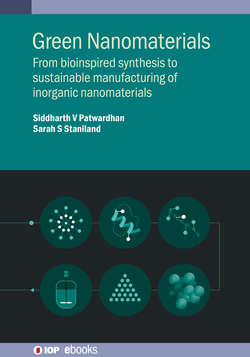Читать книгу Green Nanomaterials - Siddharth Patwardhan - Страница 7
На сайте Литреса книга снята с продажи.
Author biographies
ОглавлениеSiddharth V Patwardhan
Siddharth is currently a Professor of Sustainable Chemical and Materials Engineering at the University of Sheffield. He obtained a first degree in chemical engineering at the University of Pune (India) followed by a master’s and doctoral degrees in materials science at the University of Cincinnati (USA). He gained post-doctoral experience in inorganic chemistry at the University of Delaware (USA) and Nottingham Trent University (UK). After taking up a short-term lectureship in Chemistry, he became a Lecturer in Chemical Engineering at the University of Strathclyde in 2010. He then moved to Sheffield to take up a position of Senior Lecturer, where he was promoted to a Professor in 2018.
Siddharth leads the Green Nanomaterials Research Group (www.svplab.com), with a vision to develop sustainable routes to functional nanomaterials. His group focusses on the discovery of bioinspired nanomaterials, assessing their scalability and developing manufacturing technologies for energy, environmental, biomedical and engineering applications.
Siddharth is an EPSRC Fellow in Manufacturing and a Fellow of the Royal Society of Chemistry. He has played a key role in a number of national and international networks as well as conference organisation. One such symposium relevant to this book is on ‘Green Synthesis and Manufacturing of Nanomaterials’, as part of the ACS Green Chemistry and Engineering Conference in 2017. Siddharth is passionate about mentoring early career researchers and has received numerous awards including Dedicated Outstanding Mentor, Teaching Excellence and recognition as a SuperVisionary for all-round supervision.
Sarah S Staniland
Sarah is currently a Reader of Bionanomaterials in the Department of Chemistry at the University of Sheffield. She obtained an integrated undergraduate master’s degree in Chemistry followed by a doctorate in Materials Chemistry (2001, 2005) both at the University of Edinburgh (UK).
After her PhD she won a prestigious independent EPSRC Life Science Interface Fellowship (2005–8) at the University of Edinburgh, where she initiated the research in which she is currently active. This helped her transition from chemical material sciences to interdisciplinary work at the interface with biology. She took this opportunity to live and work in various places globally, from Cape Town to Tokyo, forming lasting collaborations. She then took up a Lectureship in Bionanoscience in the School of Physics and Astronomy, University of Leeds in 2008, where she was promoted to Associate Professor in 2013. She moved to Sheffield in 2013 and was promoted to Reader of Bionanoscience in 2016.
Sarah leads the Bionanomagnetic Research Group which studies the biomimetic synthesis of magnetic nanomaterials, particularly inspired from how magnetite nanoparticles are produced within magnetic bacteria. From a basis of material chemistry and PhD in magnetic materials, Sarah has moved into a multidisciplinary approach of using biology to control material synthesis. She has been invited to speak at and organised national and international conferences to promote this research area and been a board member of the Royal Society of Chemistry Materials Chemistry Division. This multidisciplinary research field requires a highly skilled, open-minded and diverse research team, which she is passionate about training, developing and mentoring and is very grateful to them all. Sarah is committed to teaching, in particular multidisciplinary science which falls at the interface between several standard degree subjects, and is always experimenting with novel methods and techniques to improve her teaching in this area. She has taught a course on bionanoscience (covering much of the material in this book) for ten years. Sarah has won three prestigious awards recently, including two for her research: the acclaimed RSC Harrison Meldola Award in 2016 and the Wain Award in 2017, as well as the Suffrage Science Award in 2017 for her work on the promotion of gender equality.
